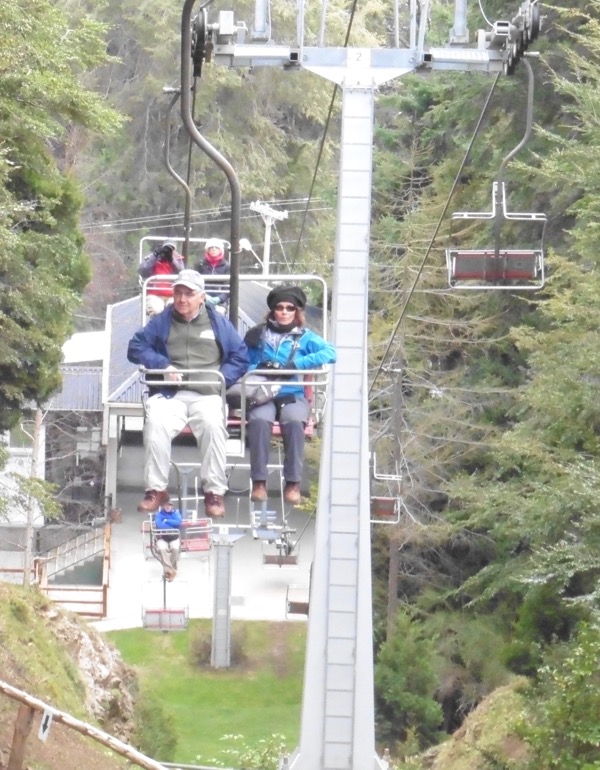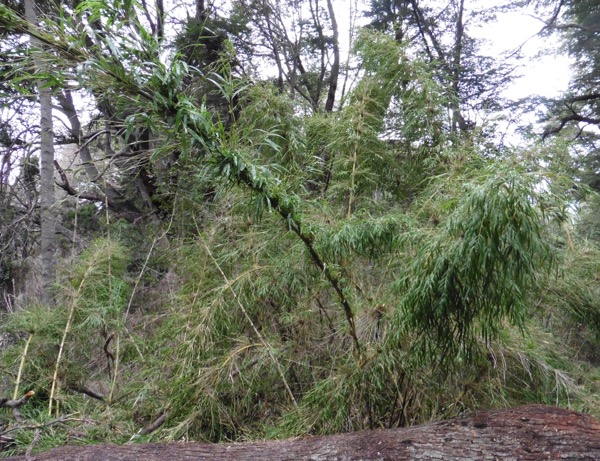Bariloche is not a name familiar to most U.S. tourists; in fact few of the stops on our tour of Patagonia would be, but it is a place of stunning beauty and fascinating culture. Looking back, it’s hard to believe the variety of experiences we had there.
San Carlos de Bariloche is nestled up against the Argentine side of the Andes mountains near the northern end of Patagonia. For a map, see the Buenos Aires post. Our hotel, about a mile south of town, had several buildings on its scenic grounds:
We stayed in a more traditional hotel building, but the view from it was marvelous:
One feature of the hotel is that in a display case next to the door of each room is a different wood carving by a famous local artist:
There must have been at least a hundred of them, each unique. I heard they were for sale, but at hundreds of American dollars apiece. Blooming trees on the grounds reminded us that October is Spring in South America:
The afternoon we arrived, we had time for a walk into town. Our first stop was the shore of the lake:
This photo is my favorite of Sebastian, our trip leader The photos above are taken looking westward, here are a couple more toward the south end of the lake:
The mountains in all the photos are, of course, the Andes. Walking along the shore of the lake, we noticed mounds of gray sand. In fact, it wasn't sand, but volcanic ash. The lake was choked with it when a volcano in Chile erupted in April of 2015. Later in the tour, we would visit that volcano. Reaching the southern end of the downtown area, we came to a bust of Jose de San Martin:
I mentioned him as being one of the founding fathers of Chile’s independence, but he played a significant role in Argentina as well. The architecture of Bariloche has an alpine feel to it:
We saw several of these stair step apartment buildings on the sides of hills:
We had our first chance to feast our eyes on some of the local arts and crafts in shop windows:
In the photo above, three small cups are featured in the foreground. These are called mate (ma-tay), and they are used for a beverage of the same name. Drinking mate is a core cultural tradition in Argentina. Mate is brewed like tea from the leaves of the mate tree. It is a sign of friendship to share a single cup of mate between two or more people, and it is always sipped through a straw, usually made of metal. Regardless of the size of the group, one person prepares the mate by packing leaves nearly to the rim of the cup, then pouring in water close to boiling. The cup can be refilled with water several times using the same set of leaves. Ornate mate cups are common gifts in Argentina, and most people have collections of them.
I took this photo simply because I was amused by mannequins with dogs’ heads:
We were now approaching the central square of the town:
Notice the white stencils on the pavement; even the statue didn’t escape:
These are a form of protest, demanding that the many people who were “disappeared” during the rule of the military junta in Argentina be accounted for. The stencil represents the head scarf of grannies; grandmothers were among the first and most vocal to protest because even a military junta is hesitant to arrest them:
Speaking of protests, the statue in the photo above is the target of protests of a different kind. The man riding the horse is Julio A. Roca who is remembered for bringing the remote interior of Argentina under government control. Unfortunately, he did this by killing and driving out the indigenous Mapuche indian people. In these more enlightened times, the Mapuche find it offensive that he is still honored with a statue.
Dinner time was approaching; this place looked good:
but our reservations were here:
which was even better (cerveceria means brewery). We had a delicious meal of locally caught fish. On the way back to the hotel, several of us stopped by one of the many chocolate shops downtown:
This one is named Mamuschka. I bought a sampler box for myself and have to say it’s the best chocolate I’ve ever tasted.
The next morning, we got on our tour bus headed south of town and were delivered to a ski lift:
That’s Paul and Diane in the chair in front of me, and:
Bill and Janie in the chair behind. Here come Tom and Kathy at the top of the lift:
(I’ll introduce all of my fellow travelers in a group photo below.) There are no ski runs from the top of this lift; instead there is some of the most stunning scenery of our tour:
Your can see why this is called the lake district. Here’s that group shot I mentioned:
Starting in the front row on the left in green is Jack, Glad, Lars, Christine, Francis, Jaye, Janie, and Bill. In the back row from the left are: Paul, Gary, Jane, Tom (my cousin), Sebastian (our trip leader), David, Diane, Kathy (Tom’s wife), and myself. Glad and Lars are employees based in Thailand who do travel arrangements worldwide for our tour company (OAT). They were along to experience firsthand one of the tours they book. Since multisyllabic Thai names are notoriously hard to remember and pronounce, they use simpler names when with westerners.
As you can see from our clothing, the morning was cool and damp, so several of us took time to warm up in the restaurant/observation tower:
To aid the warming process, most of us tried a chocognac:
As you might guess from the name, it is hot chocolate with cognac added. So good! Then it was time to head down:
Our next activity was to walk along a forest trail to learn about native plant and animal species. I was surprised that bamboo is common:
The plants above are green, but the vast majority of the bamboo were brown like this:
That’s because they have a life cycle in which they produce seed only once after 17 (I think that’s right) years of growth, and then die. The green plants are actually out of sync with the vast majority and have less opportunity to pollenate. A side effect of so many plants going to seed at once is that the rat population explodes, and when the seeds run out, they invade farms and villages like a plague.
I thought this stump deserved a photo:
Here is Santi, our local guide for the Bariloche area, pointing out some mistletoe:
At the end of our walk, we came to a very scenic lake:
Santi produced some bottles of Dulche de Leche liquor and cups, and we all had a pick-me-up.
A short bus trip further, we came to another lake shore:
at the base of the mountains:
where we were scheduled for a hike. A hike - as compared to the walk we took earlier - is steeper and doesn’t pause for interpretive explanations. As with several hikes on the tour, I found the pace faster than I liked, so I lagged behind, taking time to get the photos I wanted:
A woodpecker at work:
The faster members of our group on a ridge near the top of their hike:
We had done all this before lunchtime. On our way back toward the hotel, we stopped at a local restaurant:
We learned about how they brew their own beer:
and had a delicious lamb stew:
There was yet more astounding scenery on the drive to the hotel:
That afternoon at the hotel we got a lecture from a local resident and schoolteacher, Hans Shulls, about the role of Nazis in Argentina before and after the war. Argentina, and particularly the area around Bariloche, had a large German population before the war. As the Nazis rose to power, many fell under the sway of the argument that Germany should regain it’s rightful prestige as a world power. A vocal minority lobbied for Argentina to enter the war on Germany’s side. With the invasions and other horrors of the war, most of those voices fell silent, but many clung to their old loyalties. So, after the war, when new German-speaking people showed up and changed their names to something less Germanic, locals adopted a hear-no-evil approach. There was one notorious Nazi who lived in Bariloche for decades and was headmaster of a boys’ school before being caught and returned to Germany for trial.
That evening, we were on our own for dinner. We wandered our way into a nice Bariloche restaurant at 7pm. They had just opened and the staff were dumbfounded that anyone would eat dinner so early - civilized dinnertime in Argentina is 9 or 10 pm. However, our waiter spoke perfect English, taught us some phrases in Spanish, and was one of the most personable locals we met on the trip. It was a lovely dinner.
The next morning, we had another lecture at the hotel. This one was from a woman with Mapuche ancestry, Christine, about her struggles to keep a Mapuche school open near Bariloche. She carried her case all the way to a meeting with the president of Argentina, and has devoted herself to activism after that successful endeavor. At mid-morning, some of our group went off for an extra-cost river float trip. Personally, I was just happy for some time to hang around the hotel to assimilate all we had seen so far. I’ve been on several whitewater rafting trips before, and Sebastian said that on a scale of 1 to 6, the excitement level on this trip would be a -1. Here’s a photo of the group that did go:
I hear that the best part of the trip was the birdwatching. Sebastian caught these images of a pair of Ringed Kingfishers:
At noon, we all gathered together again and headed off for a family ranch near Bariloche:
Here, we all got to share our first mate (ma-tay):
Something about this photo always strikes me as slightly illicit, but it really is just tea. Splitting into two groups, we took our turns to go on a horse ride:
This is indicative of the scenery on the ride:
While the first group was riding, some of our ladies helped in the kitchen with meal preparation:
The men headed out back to the barbecue hut:
A hawk landed on the top of a tree nearby:
We all thought it would be great to get a picture with its wings spread, so I went over and shook the tree. It worked: everyone (but me) got a photo just as it took flight.
The climax of the afternoon was the meal:
With a tortilla in caramel sauce for dessert:
Before boarding the bus home, we got another group shot:
You see Santi (our local guide) again at the front right; other unfamiliar faces are the owners and workers of the ranch.
That was the conclusion of our time in Bariloche. The next morning we would cross the Andes by bus for new adventures in Chile.




















































































No comments:
Post a Comment